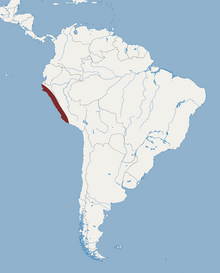Butt-eared bat
| Butt-eared bat | ||||||||||||
|---|---|---|---|---|---|---|---|---|---|---|---|---|
| Systematics | ||||||||||||
|
||||||||||||
| Scientific name of the genus | ||||||||||||
| Tomopeas | ||||||||||||
| Miller , 1900 | ||||||||||||
| Scientific name of the species | ||||||||||||
| Tomopeas ravus | ||||||||||||
| Miller , 1900 |
The snub-eared bat ( Tomopeas ravus ) is a species of bat endemic to Peru from the family of bulldog bats (Molossidae), which is particularly notable for its controversial systematic position.
description
The short-eared bat reaches a head body length of 73 to 85 millimeters. The tail becomes 34 to 45 millimeters long and, in contrast to the rest of the bulldog bats, does not protrude from the uropatagium (the tail fly skin ). With a weight of 2 to 3.5 grams, it is one of the smallest bats at all. Their fur is light brown on the top and light gray on the underside; the face, ears and membranes are black.
Way of life
Little is known about the way of life of this bat species. The short-eared bat lives in the dry coastal regions of Peru up to an altitude of 2,300 meters. She is likely to use leaves from mesquite trees as well as crevices as resting places . Pups were sighted in August and September, suggesting that the females give birth to their young during the dry season. The range of the species is estimated to be less than 100 km². Due to the destruction of their habitat restricted by the spread of settlements and agriculture, as well as the destruction of neighborhoods, especially caves, the kind of which is IUCN as endangered ( endangered ) listed.
Systematics
The snub-eared bat combines features of the smooth-nosed bat (Vespertilionidae) - such as the structure of the tail - and of the bulldog bats (Molossidae) - such as the structure of the vertebrae . In the past it was assigned to the smooth-nosed bats, but more recent, genetic studies also see it as a member of the bulldog bats. There it forms its own subfamily, tomopeatine, and is the sister taxon of all other bulldog bats.
literature
- Ronald M. Nowak: Walker's Mammals of the World. 2 volumes. 6th edition. Johns Hopkins University Press, Baltimore MD et al. 1999, ISBN 0-8018-5789-9 .
- Don E. Wilson, DeeAnn M. Reeder (Eds.): Mammal Species of the World . 3rd edition. The Johns Hopkins University Press, Baltimore 2005, ISBN 0801882214 .
Web links
- ^ Theodor CH Cole: Dictionary of Mammal Names - Dictionary of Mammal Names . 1st edition. Springer-Verlag, Berlin Heidelberg 2015, ISBN 978-3-662-46269-0 .
- ↑ a b Tomopeas ravus in the IUCN Red List of Threatened Species 2017.2. Posted by: P. Velazco, 2014. Retrieved November 25, 2017.
- ↑ Philip D. Sudman, Linda J. Barkley, Mark S. Hafner: Familial Affinity of Tomopeas ravus (Chiroptera) Based on Protein Electrophoretic and Cytochrome B Sequence Data. In: Journal of Mammalogy , Vol. 75, No. 2, (1994), pp. 365-377 Abstract
- ↑ Renato Gregorin & Andrea Cirranello: Phylogeny of Molossidae Gervais (Mammalia: Chiroptera) inferred by morphological data . In: Cladistics . tape 32 , no. 1 , 2016, p. 2-35 , doi : 10.1111 / cla.12117 .
